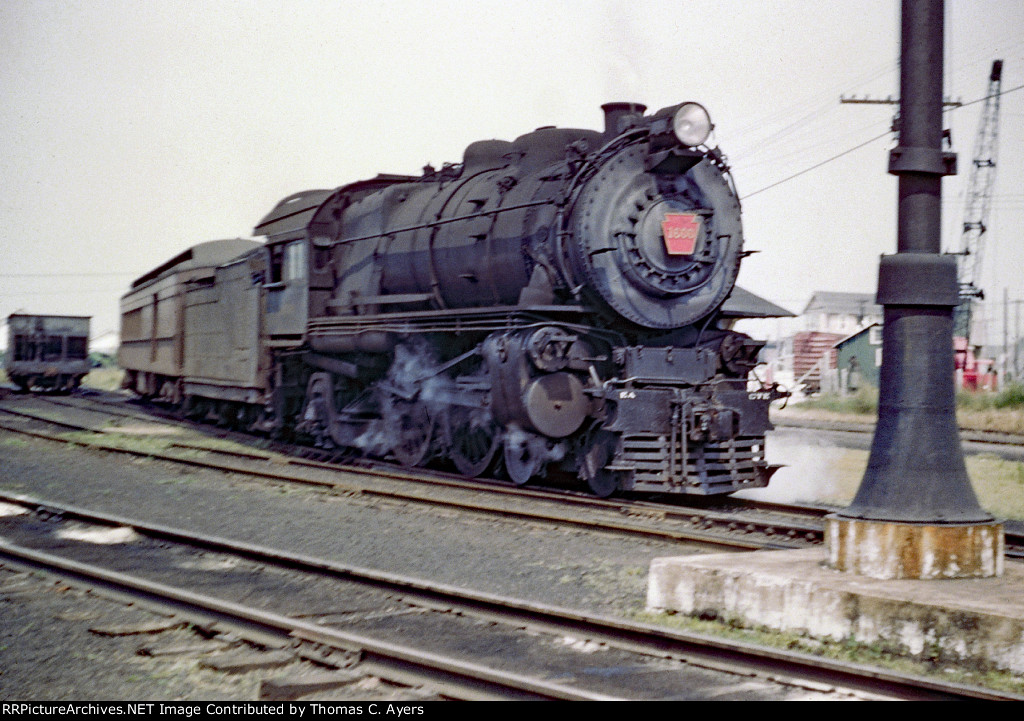The most "off the beaten track" operations of the PRR were their narrow gauge operations. The Pennsy owned a pair of 3-foot gauge railroads that they picked up in the early 1900s: the Waynesburg & Washington and the Ohio River & Western.
The Waynesburg & Washington was chartered in 1874 and opened on 1875 and ran 38 miles from Waynesburg, PA to (obviously) Washington, PA. It was a twisty, turny route with lots of grade elevation changes and even had it's own Horseshoe Curve, named after the curve at Altoona. It had very few online industries and mostly functioned as a passenger line. Due to the tight radius turns, it never had motive power larger than a 2-6-0, and even then the little Moguls had "blind" flangeless center drivers to negotiate the curves. It was not a particularly profitable line, and the Great Depression basically shuttered the line, with passenger service ending in '31. PRR continued to run a rail truck up the line every once in a while to keep it open and "in use", and then in '44 they regauged the ends to standard gauge and mostly abandoned the center section, due to the tight radius turns not working with standard gauge. PRR used the Waynesburg end and the Monongahela Railroad operated the Washington end into the Conrail era, but Conrail ended up abandoning both segments. None of the trackage is intact these days, but there are a few stations, a single Mogul (W&W #4/PRR #9684) and a passenger car preserved. The passenger car is undergoing restoration, as it was found in terrible shape, and the #4 is also being nicely fixed up. The locomotive was actually operational on a short stretch of track in the mid '70s. There is a book exclusively about the W&W, called Three Feet To The Panhandle.

The other line, the OR&W is much lamented amongst the narrow gauge fans. Originally founded as the Bellaire & Southwestern in 1877, it then consolidated with the Zanesville & Southeastern and leased the Muskingum County Railroad to become the Bellaire, Zanesville & Cincinatti. It ran from Bellaire, Ohio into Zanesville, Ohio, using the B&O standard gauge line for the last mile with a 3rd rail. At 112 miles long, it was the longest narrow gauge line in Ohio, and it earned the nickname the Bent, Zigzagged & Crooked due to all the curves. It also had 262 trestles. In 112 miles. Yes, that's more than 2 per mile. Trestles totaled up 6 miles of the line.A 34-mile run made in about three hours. This slow speed led to jokes such as this: Joe Yeagle was walking one day from his farm to Caldwell with a basket of eggs on his arm. No. 4 overtook him half a mile from town, and Engineer Barney Pennington called to Joe, "Hop on and we’ll run you to town." Joe answered, "No thanks, I'll walk. I'm in a hurry."
Construction and maintenance of the 262 trestles bankrupted the line in 1890 and in 1903 it was reorganized into the Ohio River & Western, nicknamed the Old, Rusty & Wobbly. The PRR acquired the OR&W in 1912 and continued to operate the line. Supposedly, they tried shipping an OR&W engine over to the W&W, but it was not compatible with the W&W's curvature and derailed on a turn. The OR&W was also fraught with operational perils, thanks to mudslides and all those trestles, and reportedly they once wrecked three locomotives in one day; one derailed on a mudlslide and slid down and embankment and two more collided. Like the W&W, the OR&W was basically killed by the Great Depression and PRR shut the line down in '31 and tore up the rails. Only a few passenger cars, boxcars and cabooses still exist, but all the locomotives and most of the equipment was scrapped onsite at Bellaire.

Now, this next bit is not verified and is impossible to verify, but I found someone whose father had been in Pearl Harbor around '44/'45 on liberty. He and his shipmates went on a narrow gauge train ride to the cane fields. As they pulled out of the station, the conductor came by and their father remarked that the equipment looked awfully familiar. The conductor assured him that he'd probably never heard of the little town the cars came from...Bellaire, Ohio. The conductor told him the railroad (and he didn't remember which it was) had bought used OR&W equipment. Local historians swear that everything, was scrapped on site at the Bellaire end. However, there are supposedly pictures extant in Ed Cass' Hidden Treasures (a book on the OR&W) that show locomotives, stripped of their builders' plates and other jewelry, on southbound barges passing under the B&O bridge. The tsunami that hit Hawaii after the Alaska earthquake in 1964 destroyed at least one stretch of narrow gauge on one island and threw several old narrow-gauge locomotives back into the jungle, although where exactly has been lost to time. According to this person recounting this tale, Walt Gray, director of the California State Railroad Museum, once told them he found them but that there were no plates on them, although he didn't know whether they'd been removed after they were marooned and were beyond economic recovery.
So, is it possible that the OR&W equipment was not scrapped at Bellaire, and actually shipped down to Hawaii to use on a sugar cane plantation? Maybe. Its near impossible to verify or disprove now.

















































